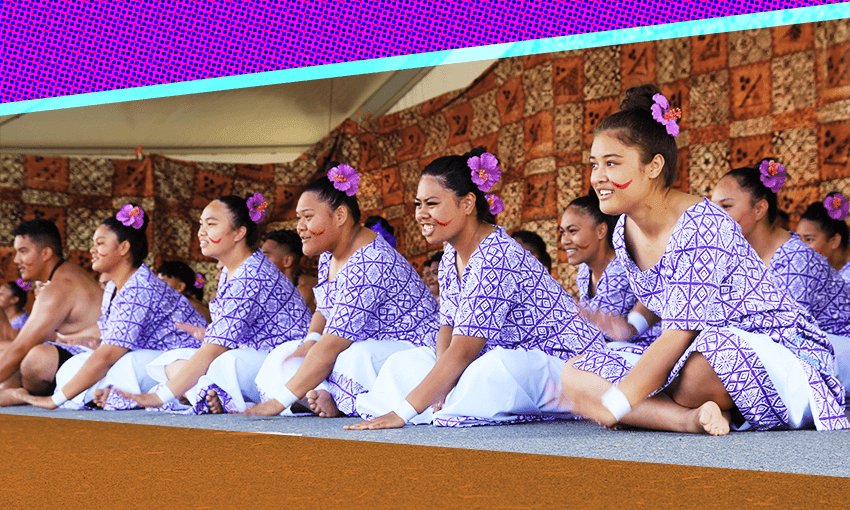The prime minister performs at his first Polyfest, while the Sāmoan stage gets off to an amazing start.
Read day two’s highlights here
A few showers didn’t stop hundreds of spectators attending the first day of performances for the Cook Islands, Sāmoan and Tongan stages at ASB Polyfest, while Diversity stage reached its final day in competition.
Prime minister Chris Hipkins made his first official outing to the event in the new role, speaking at the Sāmoan stage after Papatoetoe High School’s performance. “Celebrating your culture is a big part of your identity,” he emphasised to the students present. Deputy prime minister Carmel Sepuloni received a warm welcome from the crowd as she declared no bias as to who she was supporting, but reminded everyone “I am the MP for Kelston.”
Before Hipkins, Sepuloni and other Labour MPs left the stage, the MC of the Sāmoan stage requested that the prime minister grace the crowd with a Sāmoan siva to mark his first appearance at Polyfest, which he proudly accepted backed up closely by Sepuloni and minister for Pacific peoples Barbara Edmonds.
Here is a recap of Friday and what to expect today.
Cook Islands stage
Tamaki College was the last school to perform on this stage and brought a sea of blue with their uniform reflecting the Cook Islands flag. Their performance included the kapa rima or action songs using hands, which was beautifully in sync. Their standout moment was hoisting a few students in the air creating a triangle formation on stage, which sent the audience wild.
Sāmoan stage
Ōtāhuhu College spent hours rehearsing, with Fridays starting at 6pm and going right up until midnight and their hard work paid off with their pese o le aso section sung with such passion. This was impressive given it was the first time performing at Polyfest for many in the group. Tutor Itagia Faavaoga says their performance highlights the journey each of the students have had embracing their culture.
Marcellin College took a similar approach with grounding yourself in the Sāmoan culture as one of their tutors Natalie Toevai explained: “It is a competition, but the important take away for the students is to be proud of who they are and showcase their heritage proudly to everyone.” Toevai confirms that the lead up to Polyfest was short compared to previous years. “Usually, we have eight or nine weeks to prepare, but this year we had five weeks.”
Tongan stage
St Cuthbert’s College saw its largest Tongan group enter this year for the mā’ulu’ulu category. Student leader Alina Taumoepeau says their performance focused on sharing the Tongan culture. The mā’ulu’ulu section has the most participating schools this year and it’s a dance where the performers are seated in staggered rows, with a mix of singing and dance gestures.
Highlight of the day: Hearing the brass band accompanying De La Salle’s Tongan group sample songs such as Lil Nas X’s ‘Industry Baby’, Aqua’s ‘Barbie Girl’ and The Merrymen ‘Feeling hot hot hot’ in their taufakaniua dance. Their overall performance is a perfect example of how taufakaniua should be executed.
Lowlight of the day: Walking between stages and seeing rubbish on the ground when there are plenty of rubbish bins around the place.
Food recommendation: If you’re a sweet tooth and are wanting to try Sāmoan and Tongan desserts, head to 76ers food stall in the H1 block on the venue map, between the VIP lounge and the entrance to the Tongan stage.
On the menu is the classic fruit beverage from Tonga, mango ‘otai, German cake from Sāmoa and puteni or pudding with homemade custard. The Tongan ladies serving attendees with their own recipes of the dishes are former students at Tonga High School, class of 1976. This is their first time bringing their flavour to Polyfest and their general secretary of THS ex-students association Aotearoa chapter says they’re fundraising for their class reunion this year celebrating 75 years. “The event was supposed to happen last year, but we had to postpone it due to Covid-19 restrictions,” Katalina Hala’unga says.
General vibe: Overall, a colourful day of language, song and dance with crowds from all stages cheering all the students equally and getting into the spirit of Polyfest.
What’s on today?
Saturday is the finale of the four-day festival and that guarantees the largest crowd. The Cook Islands stage continues with their division two and one schools including Manurewa High School and Māngere College who are not strangers to this stage. Catch the two South Auckland schools performing after midday.
There are seven schools performing today on the Niuean stage and no doubt 2021’s overall winners Auckland Girls Grammar will be looking to retain that spot having won 1st place previously in categories such as the meke (a story based item that requires movements like the hopo, which is when the performers are jumping, kicking their feet up mid-air to a fast paced, kamataaga or entrance item and the fakaotiaga or exit).
At the Sāmoan stage, the all-girls and all-boys schools are participating starting with Dilworth School at around 9am. McAuley High School, the mana kura helpers of the Sāmoan stage, return this year as they only perform biannually and they are always delivering a show-stopping, enthusiastic, synchronised sasa (meaning “to strike”) group dance. The girls are the last to perform around 1.35pm.
Just like Friday’s jam-packed schedule on the Tongan stage seeing a total of 28 performances take place, Saturday has some exhilarating dances to check out such as the sōkē performed by Auckland Girls Grammar around 9.30am and Māngere College around 1.30pm. This is a dance item performed with sticks to the beat of the drum, very similar to the English Morris dance. However, if you’re wanting to experience the graceful movements of Tongan dancing performed by girls, the tau’olunga is a must-see and previous winner James Cook High School will demonstrate an excellent example of this after 2pm.
This is Public Interest Journalism funded through NZ On Air.



